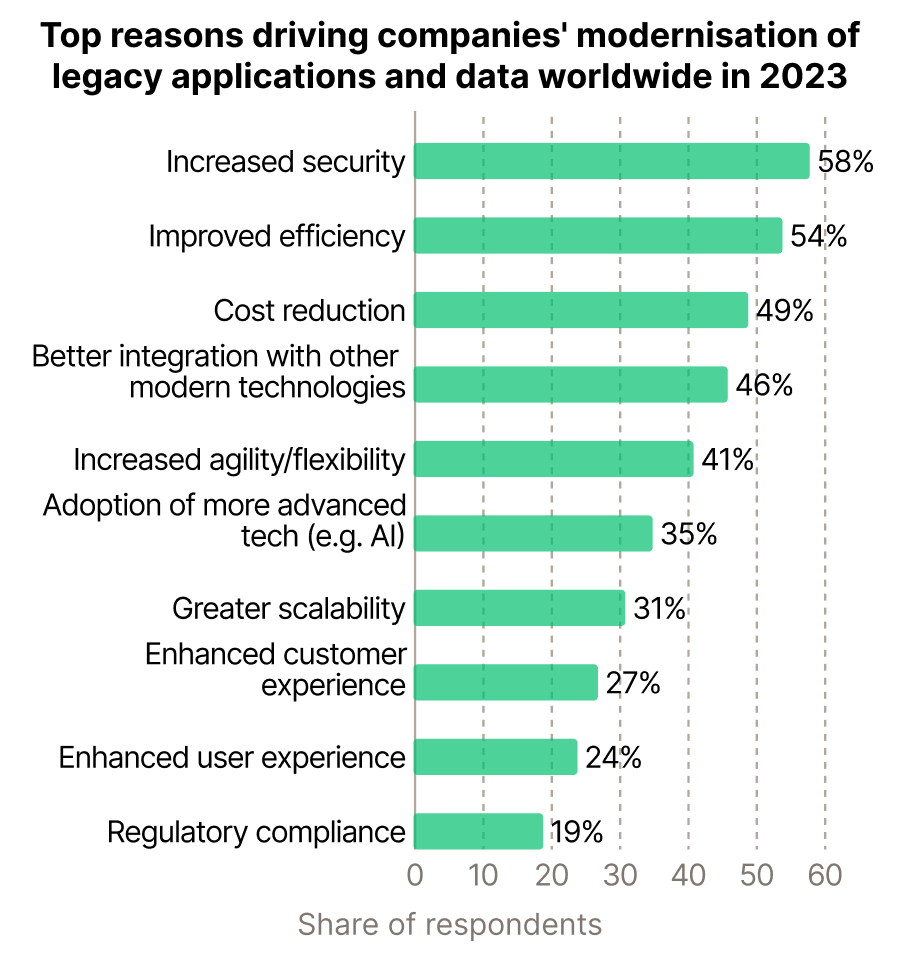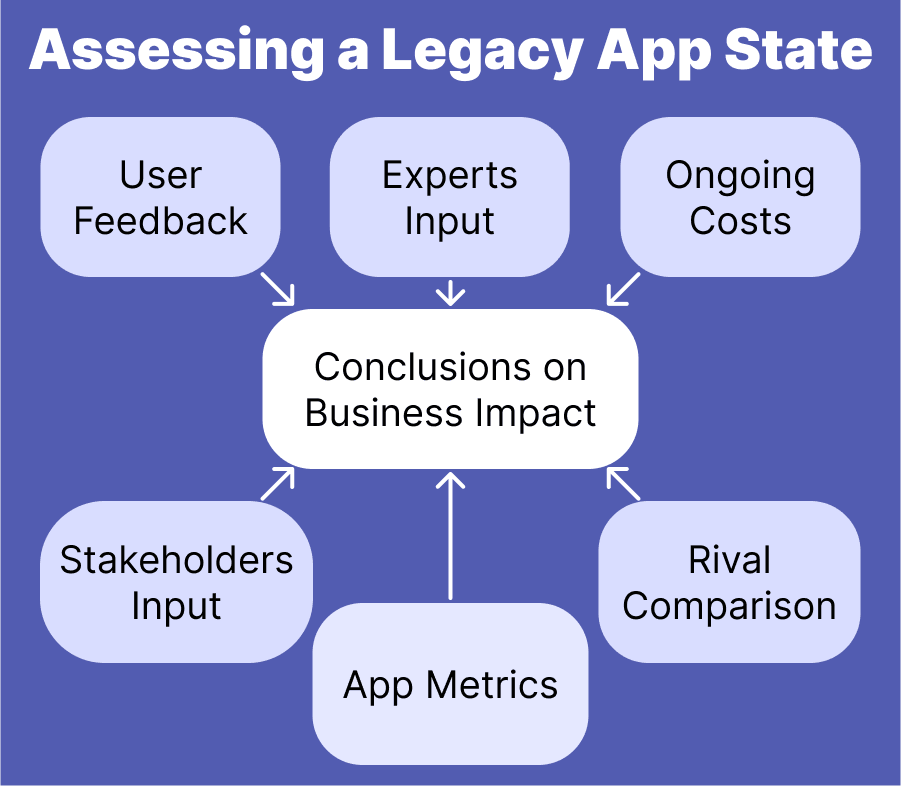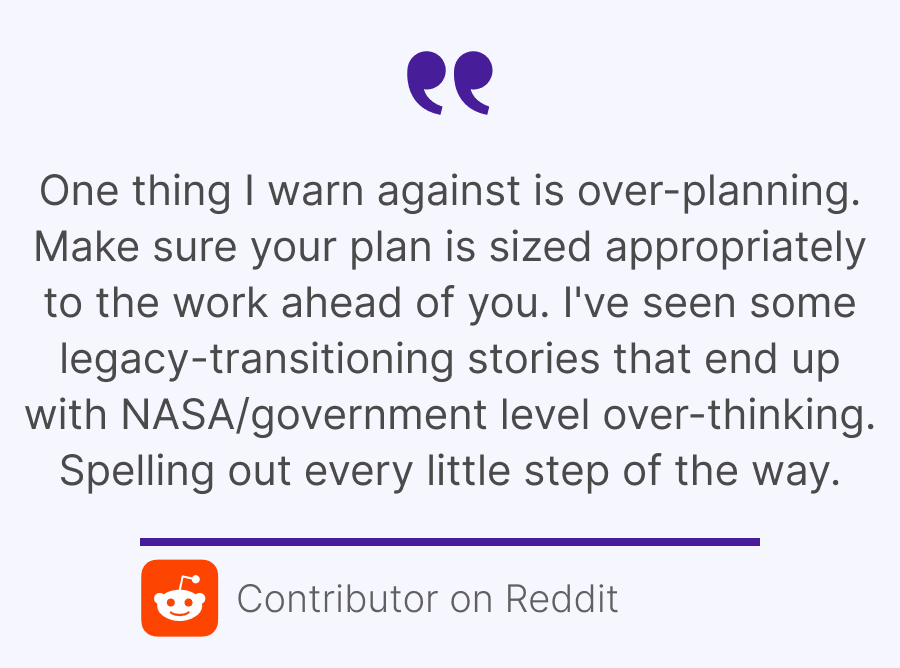When Does App Modernization Make Sense for Your Business?
Topic: Guides

February 20, 2024
At some point, every app starts to show its age. The question you face is - should I invest funds and effort into application modernization now?
We’ll provide an objective framework to evaluate whether overhauling your application makes business sense right now. You’ll get specific criteria for diagnosing performance gaps and weighing potential benefits against modernization costs and risks.
The goal is clarity on the best next step - to guide your decision between revamping your app or optimizing what you have.
Main Drivers of Legacy App Modernization
Before diving into the decision framework, let’s quickly eyeball some statistics on the top drivers behind companies modernizing legacy applications. Here's the 2023 data from Statista.

As we can see, over half of the surveyed companies in 2023 aim to boost security and efficiency through modernizing legacy apps and data. Cost cutting, integrating with new tech, and enhancing agility are also key for almost 50% of them. Despite being less common, regulatory compliance still motivates around 20%.
Let's take a closer look at each of these issues now.
Business Impact of Legacy Software
Let's examine the key negative consequences of outdated applications.
- Security and Performance: Legacy apps pose data breach threats by relying on outdated frameworks with security vulnerabilities hackers exploit. Fines, lawsuits, and reputation damage result. Performance problems also directly increase shopping cart abandonment rates and decrease customer satisfaction metrics.
- Operational Efficiency and Costs: Routine legacy app changes bog down developers for weeks instead of minutes, wasting resources better spent on innovation. Years of fixes also accumulate complex interdependencies, making quick fixes improbable without breaking other workflows.
- User Experience and Engagement: Outdated legacy interfaces drive away younger users expecting sleek mobile designs. Customers get frustrated struggling through convoluted user paths. Negative app store ratings and feedback further compound dissatisfaction. Competitors with modern interfaces collect the engagement drain.
- Business Inadaptability and Stagnation: Rigid legacy apps calcify antiquated business processes. Painful system complexity blocks adapting pricing models, partnership programs and distribution channels to market conditions. Scalability issues prevent companies from growing their operations to fulfill new customer needs.
- Innovation and Competitive Edge Erosion: While you dedicate more resources to "keeping the lights on" for creaky legacy systems, nimble competitors are aggressively building their capabilities arsenal: leveraging cloud, AI/ML, AR/VR and blockchain to pull ahead as your innovation remains handcuffed.
Identifying Signs Your App Needs Modernization
With this evidence of aging apps' impact, it’s time to examine if similar issues apply to your business. Here are practical steps to begin gathering data to inform your app modernization decisions.
Steps to Assess Your Legacy App State
- Review User Feedback: Collect and analyze user feedback to identify dissatisfaction with the app's performance, stability, features or experience.
- Consult Technical Experts: Enlist developer input on outdated technology, frameworks/languages going obsolete, architecture constraints, and technical debt quantifications indicating upgrade priority level.
- Check Maintenance Costs: Estimate allocation of engineers to maintenance and troubleshooting time sinks.
- Check App Metrics: Check stability issues, look into crashes, assess load times, evaluate how it manages more users, and see how it deals with increased traffic.
- Benchmark Competition: Download competitor apps to compare feature set, experience flows, platform/device support and integration capabilities your app is missing.
- Interview Internal Stakeholders: Gather leadership, sales and support team perspectives on the app's alignment to business goals, customer needs and their daily workflows.
- Assess Business Impact: Decide if the app supports your immediate and long-term goals, satisfies user or customer needs affordably, and offers enough business value and flexibility.
Use our checklist to assess the condition of legacy applications and identify signs your app needs an update. It makes it easy to collect, analyze, and summarize all this information.

Financial Considerations
Besides this, an app owner needs to consider the costs to make sure the investment pays off. Here are the main financial questions to address:
- How much will it cost to modernize my app?
- How long will it take to modernize my app?
- Will modernization fit within my current budget and timeline?
To get these answers, the first step is to talk with developers. They'll give you a clear picture of what needs to be done and how much it might cost.
Modernization can be complex and time-consuming, depending on the app's current state and the technologies you plan to implement. Making sure you've got enough time planned is crucial. It's better to leave some breathing room for any unforeseen challenges rather than rushing and compromising quality.
Here are a few solid modernization strategies to keep your investment smart and budget in check:
- It's crucial to prioritize tasks based on impact and feasibility. Begin by identifying which features will yield the quickest return on investment and tackle the most pressing issues first.
- Next, develop a budget-conscious plan. Understand that not everything needs to be done at once. Consider staging the modernization process to spread out costs. This approach allows for adjustments as you go, ensuring that you're not committing to unnecessary expenses upfront.
Another approach for modernization budget planning is to evaluate the potential revenue increase or cost savings from modernizing specific app features. This can help justify the investment and provide a clearer picture of the project's financial viability.

Operational Aspects to Consider
Planning app modernization goes beyond just costs. It also involves several key operational areas:
App Availability: Will the app be down during updates? Strategies should be in place to minimize disruption to users.
Data Security During Modernization: How will you protect app data throughout the process? You need protocols to address security risks and protect sensitive information against breaches or loss.
Alignment with User Habits: How will you make sure that your users will be happy with the modernized app? A plan is needed to facilitate users' switch to the modernized application, helping them adapt to the novel features and workflows.
User Support: Will user support be provided during and after modernization? This includes addressing user queries, troubleshooting issues, and collecting feedback for further improvements.
Weighing the Pros and Cons of Modernization
Below is a comparative table that outlines the advantages and risks associated with modernizing an application across various aspects.
Aspect | Modernization Advantages | Modernization Risks |
|---|---|---|
Performance | Improved speed and efficiency; better user experience. | Potential temporary disruption during transition; unforeseen performance issues with new technology. |
Stability | Increased reliability; reduced downtime and maintenance needs. | Risks of new bugs and compatibility issues during the initial phase. |
Scalability | Enhanced ability to handle user growth; future-proofing the app. | Overestimating future needs can lead to unnecessary costs. |
Security | Strengthened security posture; compliance with latest regulations. | New vulnerabilities may be introduced; requires continuous monitoring. |
Features | Ability to introduce new features; staying competitive in the market. | Feature bloat or misalignment with user needs can occur if not strategically implemented. |
User Experience | Modern UI/UX can attract and retain users; improved accessibility. | User resistance to change; requires user retraining and adaptation. |
Cost | Long-term cost savings from improved efficiency and reduced maintenance. | High upfront costs; potential for budget overruns. |
Technology Alignment | Alignment with current standards and technologies; better integration capabilities. | Dependence on vendor stability and technology lifecycle. |
Business Agility | Faster response to changing market conditions; ability to pivot and adapt business models quickly. | Misalignment with business strategy can lead to wasted resources. |
Competitive Advantage | Keeping up or surpassing competitors; meeting evolving customer expectations. | Risk of not achieving the desired market position despite the investment. |
Are There Any Alternatives to Full Modernization I Should Consider?
Various methods exist for incremental updates rather than complete modernization, emphasizing essential features first. For instance, employing microservices enables gradual application refinement, or a hybrid approach combines old and new elements. This can reduce costs and minimize disruption while still enhancing functionality.
Choosing a Partner for Legacy App Modernization
The success of navigating the risks of modernization heavily relies on the competence of your software development team.
There's a special guide we offer that outlines how not to go wrong in selecting developers. In this section, we're zeroing in on actionable advice - the aspects to consider when reviewing developers' portfolios and their bids to ensure you can gauge their app modernization skills and experience reliably.
What to Look for When Evaluating Vendors’ Portfolios and Proposals
Tips on assessing portfolios:
- Thorough Details on Portfolio Projects: Assess if project descriptions cover the specific legacy app situation modernized - not vague generalizations. This validates expertise.
- Live Demo Access to Apps in Portfolio: Check if links are provided to try the finished modernized apps live. Direct access builds more trust.
- Clear Delineation of Exact Roles on Portfolio Projects: Ensure writeups delineate exactly what subset of modernization initiatives the firm handled. Don't assume sole end-to-end responsibility.
- Recent Relevance of Portfolio Projects: Review if projects showcased were completed years in the past or on a recent timeline demonstrating updated capabilities.
- Particular Industry Expertise: Check for background modernizing legacy apps within your niche industry (health, finance etc) referenced in their project portfolio.
- Feedback from Previous Customers: Reach out to the vendor's past clients to get first hand feedback on their experience.
- Consult with Niche Experts: Engage specialists from your network who can offer valuable perspectives on a vendor's qualifications.
When assessing proposals, pay attention to the following:
- Understanding of your business: Evaluate how well what vendors offer aligns with the specifics of your business.
- Specific description of the proposed improvements: Assess whether it is described what exactly will change in the app after modernization and how much this aligns with your needs.
Technology and cost: Is it described in the proposal how exactly developers intend to solve legacy problems and how much it will approximately cost? The relevance of this info is worth cross-checking with independent experts.

Modernization Case Study: Kidiyo App Update
Real-life Example of a Successful Modernization Project
The Kidiyo mobile eLearning app from Kids Worldwide Edutainment, aimed at preschoolers, faced obstacles due to its initial development with web-based technologies, which were not suitable for the game mechanics envisioned. This issue made it difficult to develop an attractive learning setting. Furthermore, the app was burdened with severe legacy problems and got removed from the Google Play Store for breaching Google's privacy regulations. Cyfrania took on the task of upgrading the Kidiyo app.
The modernization process involved:
- Upgrading Technology: Shifting from web-based to Unity, a decision that unlocked new possibilities for game enhancement and learning engagement.
- Compliance Overhaul: Addressing the specific issue of non-compliance with Google's privacy policies to ensure the app's availability in the Play Store.
- User Experience Enhancement: Enhancements to the game's interface and mechanics that significantly improved engagement and learning outcomes for kids.
Key Factors for Application Refresh Success
The Kidiyo project's success was underpinned by:
- Right Technology Choice: Adopting Unity enabled the implementation of the app owner's vision for the game's mechanics, content, and interface, which was not possible before.
- Quick App Access Restoration: The updated app's first iteration went live after only 1.5 months.
- Cost-effective Development: Thanks to choosing the right tech and focusing on impactful features, we've significantly sped up the development compared to its previous progress.
- Focus on User Experience: Enhancements to the game's interface and mechanics significantly improved engagement and learning outcomes for children.
This modernization project shows how crucial developers' qualifications are because a wrong initial tech choice can lead to serious, costly issues including technical problems, poor user experience, and regulatory noncompliance.
Conclusion
App modernization becomes a necessity when:
- Your app shows aging signs, impacting security, efficiency, or user experience.
- Maintenance becomes overly time-consuming and costly.
- This is a necessary condition for integration with modern technologies or scaling.
Understanding when and how to modernize software can significantly impact your business's future success.
If you're at a crossroads with your legacy application and unsure about the next steps, Cyfrania is here to help. We offer a free consultation to delve into your unique challenges and provide professional advice.
Our goal is to equip you with the insights needed to make informed decisions, without pushing for solutions that don't align with your needs. Let's explore together how your business can benefit from app modernization.
Further Reading and Useful Links
- App Modernization Checklist for Product Owners - download for free
- Top reasons driving companies' modernization of legacy applications and data worldwide in 2023 - Statista insights
- Application Modernization Services Market - Global Forecast to 2027 - a report from Markets and Markets
- 7 Key Drivers of Legacy Application Modernization - an article on Medium
- 7 Options To Modernize Legacy Systems - an article on Gartner
- Why Legacy Application Modernization Is At The Heart Of Digital Transformation - an article on Forbes
- 5 Key Competitive Advantages Of App Modernization - an article on Forbes
- Seeking advice to modernize a legacy IT/Software shop - a discussion on Reddit